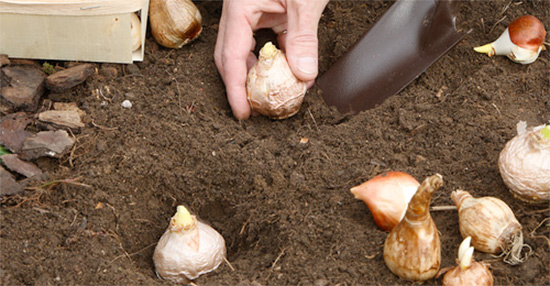For many people gardening is not the most desired hobby, and for others it is. Surely you have heard that “I have no hand for plants”. It is not that he is not skilled with plants, but that they require certain care, techniques and having certain knowledge are essential to have a lush garden full of plants and flowers.
Precisely planting bulbs requires certain knowledge, because otherwise they would not survive and our effort and dedication will have been useless.
To begin with, let’s see what bulbs are. Bulbs are certain perennial plants, whose peculiarity is that they have an organ that is usually underground, with which they survive during the hard times for them. It is their food reserve with which they will survive until the most favorable time arrives and they grow and develop again.
There are different types according to the type of organ that the plants have and also according to their shape and according to this, they can be called bulb, rhizome or tuber.
There are spring bulbs and summer-autumn bulbs. Spring bulbs will be planted between October and November and will bloom in spring; among them we find Daffodils, Tulips, Hyacinths, Crocuses, Lilies or Yellow Lilies, for example. On the other hand, summer-fall bulbs will be planted between the months of March and May and will flower during the summer and fall. This is the case of Tuberose, pink Lilies, Gladiolus, Cyclamen, Dahlias or Begonias among others.
To plant bulbs, the substrate with which it is done is also very important. It is about choosing the best land where the bulbs are going to be planted, since it is essential that it be a land that drains very well, since the accumulation of water will end up rotting the bulbs.
Once we have the purchased bulbs and the land where they are going to be planted, you will need a hoe and a bulb planter, or alternatively a shovel.
Instructions for planting bulbs
- The main thing is that you choose bulbs in good condition. They must be hard, without bumps or holes. Press a little with your fingers to make sure of its condition, because if it sinks a little it will be better not to take it.
- You can plant them both in pots and in the garden soil. But you should always turn the soil (plow it) so that it is loose and workable. In the case of the garden you can help yourself with a hoe, and in the case of flower pots it is sometimes more comfortable to do it with your hands.
- The time to plant them is very special, because depending on the bulb they will have to be planted keeping more or less a certain distance between one bulb and another. Normally, a distance of between 5 and 20 cm is kept. A specific depth is also required depending on the bulb species. You can look it up on the label, where it’s usually noted, but it’s usually twice the size of the bulb anyway. Finally, remember that the part where the plant comes out, called the budding point, must be facing up.
- As for the fertilizer, you can put a little or not, but never go overboard, because the bulb already contains food in reserve.
- Finally, it only remains to water them. They need little water. You should never let the planted area flood, otherwise the bulb will drown.
- There are only a few bulbs that can remain in the ground throughout the year, the rest must be carefully dug up and kept in a box, bowl, etc. But put sand or sawdust and store them in a dry, dark and cool place.
- There is a variety called forced bulbs that are special to bloom indoors and that their flower lasts all year.
- If you’ve bought bulbils (small bulbs that aren’t ready to bloom yet) plant them in a pot for a year or two, and then transplant them into the garden if you like.
What do you need to plant bulbs?
- Hoe
- Shovel or bulb planter
- bulbs
- Water
Tips for planting bulbs
- Plant the bulbs in very sunny areas, although there are some that will survive in semi-shaded areas.
- Remember to keep the planted area well drained and fertilized.
- The flowers will be beautiful but they do not last very long, so if you plant large areas most of the year you will see a great emptiness in that area. It is best to plant them where there are more bushes and flowers so that they mix and visually there is not a great emptiness when the bulbs are at rest.
- When the flowers of the spring-flowering bulbs fall off, the stems are very ugly, but never cut them, otherwise you will damage the bulbs, weakening them and in the following season the flowers will be smaller and in less quantity. Once it is very shriveled you can cut it, but if you are not sure, leave it longer.
- It is advisable that you change the bulbs of site every year or every two years.

















